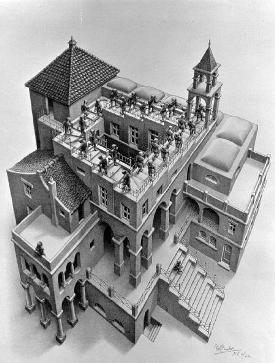Journey to Infinity: Escher’s World of Wonder
A few days ago I visited M.C. Escher exhibition on another Educators’ Event conducted by ArtScience Museum, Singapore. (The museum has been religious in their effort to extend the wonder of art and science to its beneficiaries – the students).
M.C. Escher has been a household name in art discussions, and as far as my limited knowledge went, I had always known him for his optical illusion art. I am sure we are all quite familiar with some of his work:

‘Relativity’ (1953), which reminds me of Doraemon’s gravity paint…

Doraemon’s Gravity Paint’s effect. I love this chapter of Doraemon. Heartwarming ending (OK, different topic)
Some other popular works by Escher:

‘Ascending and Descending’ (1960), an artistic implementation of the Penrose stairs (one of impossible objects). Popularised by the 2010 movie ‘Inception’, and (I believe) the inspiration of award-winning, graphically-awesome game ‘Monument Valley…

‘Sky and Water I’ (1938). You can spot this graphic printed on many places, most likely on a hipster’s tote bag.

‘Day and Night’. A very cool, mindboggling symmetry.
And this one…

‘Drawing Hands’ (1948)
So yeap, I thought I was quite familiar with his body of work, and I thought I knew what to expect when I went there. But…
Have you heard of people saying that seeing real paintings is such an entirely different experience from seeing the pictures in books or online? Well, it was not until I went to this exhibition that I could really appreciate that saying.
Most of Escher’s works are not so big, and they are framed and hung on the walls of the exhibition space. I got to stand really close to scrutinize his lines. Close enough to see that the work is done by Escher’s own hands, and at the same time to be mind-blown by the fact that it is looking humanely impossibly perfect. (Take note that these works were produced from around 1910s to 1960s during which no digital enhancement could possibly be done. What kind of sorcery is this? I thought to myself with mouth agape). This exhibition is also an eye-opener to the potential of traditional printing methods (especially lithography and wood cut) in creating jaw-dropping works.
And there are works that made me feel amazed for the fact they looked very advanced for the time, and can easily pass for something that is done today.
And then there is his brilliance in producing works that tickle the mind.
We are all familiar with a simple tessellation (an arrangement of shapes in a repeated pattern without gaps and overlapping) like this:

However, his works show that the term ‘tesselation’ can mean so much more:

‘Horsemen’ (1946). How on earth could he think of this?
And there are many other awesome works that I will not disclose further here. See them for yourself!
FYI. Like other exhibitions held in the fingers of the museum, this exhibition is divided into a few segments:
- Early works: Art Nouveau and Nature (Escher was really into nature)
- Metamorphosis
- Tesselation
- Commercial Works
- Exploring The Infinity
- Escher Mania (Escher-inspired works, mainly in pop culture)
At the end of the tour, the tour guide asked us which work was our favorite. I paused for a while, thinking, and I replied, “I don’t know, there are so many… (mention a few titles)…”
She asked again, “but which one do you like the most?”
I paused again, only to reply after that, “I really don’t know.”

